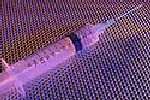
FRIDAY, April 24, 2014 (HealthDay News) — With narcotic painkiller abuse now linked to 142 cases of HIV in rural Indiana, U.S. health officials are alerting other states to watch for clusters of HIV and hepatitis C among injection drug users.
The Scott County epidemic is “a powerful reminder that people who inject drugs are at high risk for both HIV and hepatitis,” said Dr. Jonathan Mermin, director of the National Center for HIV/AIDS, Viral Hepatitis, STD, and TB Prevention.
HIV, the AIDS-causing virus, “can gain ground at any time unless we remain vigilant about prevention, testing and care,” he said during a Friday morning news conference.
There is no indication that HIV infection among injection drug users is spreading beyond this area of Indiana, he said. “But it will be critical to examine all available data on the state and local level to assess whether HIV is increasing among injection drug users in any area and to be sure any increases are being detected,” Mermin said.
The U.S. Centers for Disease Control and Prevention estimates that about 3,900 new cases of HIV each year are attributable to injection drug use. “That’s down nearly 90 percent from a peak of 35,000 annually in the 1980s,” Mermin noted.
However, because of widespread narcotic painkiller abuse in the United States, hepatitis C infections increased 150 percent between 2010 and 2013, Mermin said. Most of these infections have resulted from sharing needles, he pointed out.
The CDC health advisory is designed to alert state health departments to the hepatitis C epidemic and the possibility of current or future HIV outbreaks among people who inject drugs, Mermin said. Hepatitis C can lead to serious liver disease, including cancer.
“We are asking states to take a look at their most recent data on HIV and hepatitis C as well as overdose deaths and admissions for drug treatment — and drug arrests — to help identify communities that could be at high risk for unrecognized clusters of hepatitis C and HIV infection,” he said.
Indiana State Health Commissioner Dr. Jerome Adams said during the news conference that the Scott County outbreak is unique because the rural locale has had little HIV previously and because it’s related to pervasive injection drug use.
“We literally have new cases being reported every day on an hourly basis,” Adams said.
As part of Indiana’s response to the outbreak, Gov. Mike Pence has issued an executive order allowing a 30-day needle exchange program. The program has been extended for another 30 days.
Also speaking at the news conference, Dr. Joan Duwve, chief medical consultant to the Indiana State Department of Health, said nearly all of the HIV cases identified have been related to injections of the painkiller oxymorphone (Opana).
Even though oxymorphone tablets are tamper-resistant, Duwve said drug abusers have found a way to make the drug injectable.
Addicts inject themselves as many as 10 times a day to maintain their high and prevent withdrawal, she said. Frequent injections and needle-sharing increase the risk of HIV transmission, she said.
Steps taken by the state health department include the launch of a public education and testing program, she said. This is “a one-stop shop to provide services to the community, including HIV testing, registration for insurance coverage and referral to addiction treatment services,” Duwve said.
Because Scott County has only one doctor, Duwve said they’ve set up an HIV clinic staffed by medical teams from Indiana State University.
Mermin said that, “The situation in Indiana is a warning that we cannot let down our guard against this deadly infection.”
More information
For more on HIV, visit the U.S. Centers for Disease Control and Prevention.
Copyright © 2025 HealthDay. All rights reserved.

